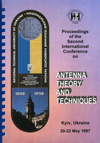High efficiency electroacoustic transducer for gaseous mediums
DOI:
https://doi.org/10.1109/ICATT.1997.1235173Abstract
The low acoustic resistance of gases restricts the possibility to generate high intensity sound fields by acoustic antennas. The boundary value of sound intensity for an air is restricted by non-linear effect and equals 160 dB or 10 W/m. The amplitude of gas particles' displacement in the wave reaches 0.5 mm at the frequency 10 kHz. To obtain such displacements directly by a piezovibrator — an active element of an acoustic antenna is not succeed. To increase the amplitude of vibrators' oscillations matching systems are used, such as solid-state concentrators, acoustic transformers, resonant cavities and matching coatings.
The solid-state concentrator for a mechanical vibrating system is presented.
References
Gorbatov, A.A.; Rudashevskii, G.E. Acoustic Measuring Methods of Distance and Treatment. Moscow: Energiia, 1981 [in Russian], 206 p.
Vakhitov, Ya.Sh. Theoretical Foundations of Electroacoustic and Electroacoustic Equipment. Moscow: Iskusstvo, 1982 [in Russian], 415 p.
Isakovich, M.A. Common Electroacoustic. Tutorial. Moscow: Nauka, 1973 [in Russian], 495 p.

